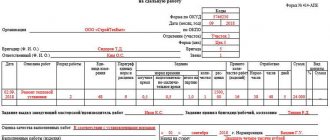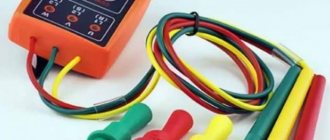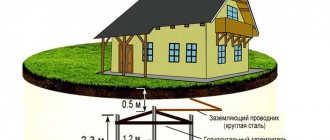4.5. In electrical installations with voltages up to 1000 V, when working under voltage, it is necessary to:
relieve voltage from other live parts located near the workplace that are energized, which may be accidentally touched, or protect them;
work in dielectric galoshes or standing on an insulating stand or on a rubber dielectric carpet;
use an insulated tool (screwdrivers must have an insulated shaft) or use dielectric gloves.
It is not allowed to work in clothes with short or rolled up sleeves, or to use hacksaws, files, or metal meters.
4.6. It is not allowed to work in electrical installations in a bent position if, when straightened, the distance to live parts is less than the distance specified in Table No. 1.
When working near unprotected live parts, it is not allowed to be positioned so that these parts are behind the worker or on both sides of him.
4.7. It is not allowed to touch insulators or insulating parts of live equipment without using electrical protective equipment.
4.8. In crossing spans in outdoor switchgear and on overhead lines, when replacing wires (cables) and related insulators and fittings located below live wires, ropes made of vegetable or synthetic fibers. The ropes should be thrown in two places - on both sides of the intersection, securing their ends to anchors and structures. Lifting the wire (cable) should be done slowly and smoothly.
4.9. Work in the outdoor switchgear on wires (cables) and related insulators, fittings, located above wires, and energized cables must be carried out in accordance with the PPR approved by the head of the organization or separate unit. The PPR must provide measures to prevent the lowering of wires (cables) and to protect against induced voltage. It is not allowed to replace wires (cables) during this work without removing the voltage from the crossed wires.
4.10. Workers should remember that after the voltage at the electrical installation has disappeared, it can be reapplied without warning.
4.11. Work in unlit places is not allowed. The illumination of work areas, workplaces, passages and approaches to them must be uniform, without the glare of lighting devices on workers.
Work without stress relief
Work without relieving voltage near or directly on live parts. When performing work without removing the 380/220 V voltage in heat shields, computers or measurement circuits, special precautions must be taken. Workers must work in dielectric galoshes or standing on an insulating base. They should use tools with insulating handles; screwdrivers should have blades coated with an insulating coating. [p.161]
When performing work without removing voltage in computer circuits with a voltage of no more than 42 V, compliance with the above requirements is not necessary. [p.162]
Insulating pliers for voltages of 6–35 kV (Fig. 11.4) are intended for replacing fuses such as PKT-6, PKT-Yu, etc., as well as for removing insulating pads and fences from live parts that are installed while work is being performed without removing the voltage from live parts of an electrical installation. Clamps for voltage 6-35 kV are made in the form of an insulating rod from paper-bakelite tubes coated with varnish. The working part is in the form of steel jaws, the grip of which [p.158]
According to the safety regulations, work carried out in existing electrical installations, with regard to electrical safety measures, is divided into work with voltage relief without removing voltage on live parts and near them, as well as work without voltage relief away from live parts that are energized. [p.182]
Work without relieving voltage on live parts and near them includes work performed directly on these parts, as well as work performed at distances from live parts from people, used tools and devices, and temporary fences when there is voltage [p.182]
Due to the significant danger of electric shock during work without removing the voltage in electrical installations above 1 kV, at least two workers from among the operational and repair personnel must participate simultaneously, with the eldest with a safety qualification group of at least IV, the rest - not below III. At work, it is mandatory to use protective equipment to isolate a person from live parts or from the ground. The same work in an electrical installation up to 1 kV, taking into account their small dimensions, is carried out under the condition that live parts under voltage, which can be accidentally touched, are fenced off near the workplace. You must work in dielectric galoshes or on an insulating stand or mat; use the tool with insulating handles. It is prohibited to work in a bent position if, when straightened, the distance to live, non-disconnected parts is less than 0.6 m. It is unacceptable for unprotected live parts to be located behind the worker or on both sides. [p.183]
Work without voltage relief away from live parts that are energized is considered to be work in which accidental approach of working people and the repair equipment and tools they use to live parts is excluded at a distance of less than 0.6 m (1 m for mechanisms) and no acceptance is required special measures to prevent such an approach. This is, for example, work on cleaning control panel panels from dust when there are no live parts on the front side, cleaning the electrical room, replacing lamps in fittings and other work up to permanent fencing of live parts. [p.184]
The work order is handed over to the operational personnel before work begins; it is issued in two copies (work order form—see Appendix B9 [8]) for one work performer (supervisor) with one team. For the same type of work performed under voltage by one team (for example, load measurements), as well as for work without voltage relief, one general work order can be issued for their alternate production at a number of connections, in the same or different switchgears, in different rooms of the substation. Registration of transfer of a team from one workplace to another is required only when moving from one plant to another. For all work performed with voltage relief (in various places) at a given substation, in a given switchgear, one work order is issued. [p.186]
It is allowed to combine the duties of the person issuing the work order and the responsible work manager (for work without stress relief, he is not assigned). When working with complete stress relief, its functions can be performed by the workman. The validity period of the work order is determined by the volume of work, but it should be no more than 6 days, and daily permission to work is issued, issued in the appropriate column of the work order. [p.167]
Repair, installation, adjustment, construction and other work performed in existing electrical installations, including overhead and cable lines, with regard to safety measures, are divided into three categories: work with voltage relief; work without voltage relief; work under voltage. [p.419]
Work without voltage relief is carried out without shutting down the electrical installation. In this case, it is allowed to work behind permanent and temporary fences of live parts, on equipment housings, on the surface of cable sheaths, as well as at distances from unfenced live parts that are energized more than those indicated in the table. 12.1. [p.420]
The appointment of a responsible manager is not necessary when working with complete and partial voltage relief in electrical installations with a simple and clear diagram, with one busbar system, at the workplace of one connection, when working without voltage relief away from live parts, as well as when working side by side in electrical installations up to 1000 V and work performed according to orders. In all these cases, the composition of the team is determined by the person issuing the order or giving the order, and the functions of the responsible leader are performed by the work performer. [p.236]
It is allowed to issue one work order for several works of the same type, provided that they are carried out alternately without removing the stress, as well as in cases where the work will be carried out in different places at several connections of the same substation with the complete removal of stress from this substation. The same type of work without removing the voltage from the electrical installation can be measuring the load with electrical clamps in the RP cells and in the chambers of power transformers, adding or taking an oil sample from the tanks of power transformers, removing or installing electrical measuring instruments when feeding them through instrument transformers, etc. [p.236 ]
B11-1-20. Work without relieving voltage near and on live parts that are energized is considered [p.132]
BT1-1-21. Work without voltage relief, performed away from live parts that are energized, is considered to be work in which accidental approach of working people and the repair equipment and tools they use to live parts at a dangerous distance is excluded and does not require the adoption of technical or organizational measures (for example, continuous supervision) to prevent such an approach. [p.132]
BI-3-21. For the same type of work performed under voltage by one team, as well as for work without voltage relief, one general work order can be issued for their alternate production at several connections in the same or in different switchgears, in different rooms of the substation. [p.144]
BP-3-50. When working without stress relief, obtaining access to another workplace is required only when transferring a crew from an open switchgear of one voltage to an open switchgear of another voltage or from one room of a closed switchgear to another. [p.148]
BP-3-59. Work carried out by order without removing the voltage away from live parts that are energized also includes work on installation, testing, adjustment, removal for repair and installation of measuring instruments, relay protection devices, automation, telemechanics and communications (voltage below 1000 V) , work in the drives of switching devices, on secondary circuits, in the circuits of electric drives of steam-water fittings, performed [p.150]
Measures to ensure the safety of work without removing voltage near and on live parts that are energized [p.152]
Without a work order, by order transmitted directly or by telephone and recorded by the person receiving it in the operational journal, work can be carried out without removing the voltage away from live parts that are under voltage, as well as short-term and small-scale work with and without removing voltage from an electrical installation, performed by operating personnel or under their supervision. [p.236]
According to orders, the following work can be carried out without issuing a work order without removing the voltage, away from live parts that are energized. [p.239]
Work without relieving voltage near live parts that are energized, or on the live parts themselves, is carried out in order. In this case, it is necessary to ensure a safe location of workers in relation to energized live parts, observing the minimum permissible distances. During the performance of work, there must be continuous supervision of workers, providing them with protective equipment and devices. Workers must wear clothing with the sleeves pulled down and buttoned at the wrists and a hat. You need to work from the floor or from a sturdy scaffold or scaffold. [p.240]
Repair work in existing low-voltage electrical installations, as a rule, must be carried out after disconnecting the voltage and removing the fuses. Signs should be posted on switches and switch handles: Do not turn on, people are working. In some cases, if it is necessary to carry out repair work without relieving the voltage, the conditions for safe operation should be determined by local instructions. [p.655]
Ha BJI 110 kV and above, support structures must allow repair work without voltage relief (see 2.5.72). [p.356]
In electrical installations with voltages up to 20 kV, linings made of solid electrical insulating material (getinax, fiberglass, etc.) are used. In electrical installations with voltages up to 1000 V, flexible pads with a thickness of at least 5 mm made of dielectric rubber can be used. They cover live parts during work without removing voltage. [p.21]
On overhead lines of 110 kV and above, the support structures must allow repair work without voltage relief (see 2.5.72). [p.253]
On overhead lines of 110 kV and above, the support structures must allow repair work without voltage relief (see 2.5.71). [p.233]
When the alarm device is triggered in the event of a decrease in the insulation level relative to ground in the operating current circuit, measures must be immediately taken to eliminate the faults. At the same time, work without removing the voltage in this network, with the exception of searching for the location of insulation damage, is prohibited. [p.211]
Work without relieving voltage near live parts that are energized is such work in which it is necessary to take special measures to prevent the possibility of firefighters approaching, applying jets of water, foam, or placing the mechanisms used at a dangerous distance to parts that are energized. [p.88]
Work without relieving voltage away from live parts that are energized is considered to be work in which the possibility of accidental approach of firefighters, equipment, jets of foam or water to live parts that are energized is completely excluded. [p.88]
Without a work order, by order transmitted directly or by telephone and recorded by the person receiving it in the operational journal, work can be carried out without removing the voltage, away from live parts under voltage, as well as short-term and small-scale work with and without removing voltage from an electrical installation, performed by operating personnel or under their supervision. [p.224]
The appointment of a responsible manager is not necessary when working with complete voltage relief and with partial voltage relief in electrical installations with a simple circuit at one workplace of one connection, when working without voltage relief away from live parts, as well as when working side by side in installations up to 1000 V and work performed by order. In all these cases, the composition of the team is determined by the person issuing the order or order, and the functions of the responsible manager are performed by the work performer. [p.225]
According to orders, the following work can be performed without removing voltage away from live parts that are energized [p.229]
By verbal order, work is carried out without relieving the voltage away from live parts, as well as short-term and small-scale work with full. or partial relief of voltage near and on live parts. These works are carried out by operational personnel or under their supervision by maintenance personnel. The order to perform work is one-time in nature and is valid for one day. If it is necessary to repeat the work, the order is given again with a mandatory entry in the operational journal. The outfit is issued to the operational personnel servicing the member.ktrpustya.novka. before the brigade begins work. The work order is issued for five days. During breaks in work, the work order remains valid if there were no switches and the working conditions remained unchanged. [p.81]
By order, work can be carried out without removing voltage from live parts that are under voltage, lasting no more than one shift, unscheduled work caused by production needs, lasting up to 1 hour, as well as work with removing voltage from electrical installations with voltage up to 1 kV, lasting no more than one shifts. Registration of work, admission and supervision are similar to work on the job. The order is recorded in the operational journal by the person issuing it or, on his instructions, received directly or through communications by the operational personnel. The log indicates who gave the order, the content and place of work, the category of work performed in relation to safety measures, a list of technical and organizational [p.191]
The work performer can take part in work with complete voltage relief, as well as in work without voltage relief away from undisconnected equipment with voltages exceeding 1,000 V. [p.34]
Under normal operating conditions, it is allowed to measure the load with current clamps on live parts or in close proximity to them, check the heating of contacts, disconnect devices and meters from current transformers (after shunting the secondary winding), adjust remote control devices and some other work in agreement with the inspection Gosenergonadzor. These works must be carried out by at least two persons in emergency cases, and if it is impossible to relieve voltage in installations up to 500 V, other work without removing voltage, specified in the local instructions, is allowed. Work under voltage must be carried out under the guidance of a work manufacturer with qualifications of at least group IV, strictly observing the following conditions: a) work is carried out wearing dielectric gloves, standing on an insulating base b) use tools with insulated handles c) adjacent live and grounded parts must be fenced with using rubber mats, micanite sheets, getinax, textolite, etc. d) the sleeves of clothing should be lowered and fastened at the hands, it is necessary to wear a headdress e) perform the work without using hacksaws, files and steel meters. It is prohibited to carry out work on live parts that are not disconnected if they are located in particularly damp rooms, with conductive dust or caustic vapors that are dangerous in terms of explosion and fire. [p.36]
Such work includes work on galvanic processing of metals, enameling of wire, hot processing of copper and lead, painting work using nitro varnishes, nitro enamels containing lead, luminous paints, work of a sandblaster, mechanic for repairing technological equipment, electrician in hot, hazardous and explosive workshops, electrician for servicing electric precipitators, repairing transformers, work without removing the voltage, electrician, electromechanic, compressor unit operator and others. If technical school students under 18 years of age are involved in the specified professions for training or practice, then the duration of their work and stay in hazardous workshops should not exceed 3 h per day. It is prohibited to involve teenagers in night and overtime work, as well as on duty after the end of the working day. [p.116]
Without an order in the course of routine operation, work can be carried out without removing voltage away from live parts, such as cleaning the premises and territory of the outdoor switchgear, transporting goods, unloading and loading them on the territory of the outdoor switchgear, repairing lighting equipment, caring for brushes, slip rings and collectors of electrical machines, etc. (p, a - c), as well as work in electrical installations up to 1000 V with complete or partial voltage relief for the repair of individual ballasts and electrical receivers, replacement of fuses, etc. [p.242]
Special electrical safety measures when working without removing voltage near and directly on live parts. When working near live parts that are energized, it is necessary to ensure that the workers are positioned appropriately in relation to the live parts, observing the minimum permissible distances to them. The worker must be positioned so that the live parts of the electrical installation are in front of him and only on one side. It is unacceptable to work if live parts that are not disconnected are located behind the worker or on both sides, as well as to work in a bent position if, when straightened, the distance from live parts to any part of the body is less than permissible. The proximity of the worker's hands to live parts that are energized must be no less than the length of the insulating part of the protective equipment used - electrical and insulating clamps, rods, etc. [p.243]
BP-4-1. When working without removing the voltage near live parts that are energized, measures must be taken to prevent workers from approaching these live parts at distances less than those specified in BP-2-2. [p.152]
Protective devices include the so-called shield guards, which protect against touching live parts when performing work without relieving the voltage in conditions of extremely limited distances. [p.199]
2. Basic means of protection in electrical installations with voltages above 1000 V.
Safety regulations in industrial production
Compliance with safety precautions at industrial facilities when working with electricity is an integral part of the entire production process. In case of non-compliance with these norms and rules, the administration of the enterprise may impose penalties in the form of deprivation of monetary remuneration or the imposition of a fine. If accidents occur, those responsible may be subject to administrative or criminal liability. That is why, when working with electricity, employees must strictly follow safety regulations:
- Persons with theoretical and practical knowledge and skills who have received documentary evidence of this in the form of education diplomas are allowed to work with electric current;
- Persons who have been trained and certified in safety precautions are allowed to work with electric current, which must be confirmed by an appropriate certificate and an entry in the safety log indicating the name, position and date of the instruction and passing the exam. Everything must be confirmed by the personal signature of the employee being examined;
Logbook for registration of safety briefings when working with electric current
- All employees are certified, regardless of position. Team leaders who do not have direct contact with electric current during the production process bear full responsibility for their subordinates performing the work;
- It is forbidden to start work without wearing a special protective uniform;
- Electrical equipment must be grounded and suitable for the work being performed;
- It is prohibited to use electric tools in places with a high degree of fire and explosive areas that do not have the appropriate protection class;
- The use of faulty electrical equipment is prohibited;
- It is prohibited for strangers to be in the danger zone during work;
- When working in a damp environment (indoors or outdoors), it is permitted to use a tool with the appropriate protection class, which must be confirmed by a certain sticker on the device body:
- Protection class 1 is intended for work in safe rooms;
- Tool protection class 2 can be used both indoors and outdoors in areas with increased danger;
- The 3rd protection class allows the equipment to be used in particularly dangerous places.
- Before starting the work process, the integrity of electrical devices, wires, adapters and sockets is inspected: for the presence of grounding cables, absence of damage to the housing. Idle operation is checked. Only after this is power supplied to the installation;
- When changing nozzles and spare parts of equipment, before starting the process, the entire installation must be de-energized;
- When working with particularly powerful mobile electrical installations, the use of specialized wires with the necessary flexibility and degree of protection from mechanical stress, grounding and RCD is required.
Entry from the magazine on safety precautions when working with electric current
Compliance with safety precautions when working with electric current plays a huge role, both in the industrial sphere and in the life processes of every person, regardless of age range, because not only health, but life depends on it. Therefore, an equally important factor is the knowledge of the correct operation of electrical equipment and the ability to provide first aid if necessary.
Particular attention is paid to this issue in large enterprises, where annual seminars are held with practical and theoretical tasks for employees on the subject of first aid, as well as consideration of behavior in the event of critical situations at work.
Providing first aid to the victim
An equally important factor is compliance with safety standards in everyday life when operating household appliances. Compliance with basic rules can eliminate the occurrence of dangerous situations, preserving the life and health of a person and the people around him at a critical moment.
Safety regulations in industrial production
Compliance with safety precautions at industrial facilities when working with electricity is an integral part of the entire production process. In case of non-compliance with these norms and rules, the administration of the enterprise may impose penalties in the form of deprivation of monetary remuneration or the imposition of a fine. If accidents occur, those responsible may be subject to administrative or criminal liability. That is why, when working with electricity, employees must strictly follow safety regulations:
- Persons with theoretical and practical knowledge and skills who have received documentary evidence of this in the form of education diplomas are allowed to work with electric current;
- Persons who have been trained and certified in safety precautions are allowed to work with electric current, which must be confirmed by an appropriate certificate and an entry in the safety log indicating the name, position and date of the instruction and passing the exam. Everything must be confirmed by the personal signature of the employee being examined;
- All employees are certified, regardless of position. Team leaders who do not have direct contact with electric current during the production process bear full responsibility for their subordinates performing the work;
- It is forbidden to start work without wearing a special protective uniform;
- Electrical equipment must be grounded and suitable for the work being performed;
- It is prohibited to use electric tools in places with a high degree of fire and explosive areas that do not have the appropriate protection class;
- The use of faulty electrical equipment is prohibited;
- It is prohibited for strangers to be in the danger zone during work;
- When working in a damp environment (indoors or outdoors), it is permitted to use a tool with the appropriate protection class, which must be confirmed by a certain sticker on the device body:
- Protection class 1 is intended for work in safe rooms;
- Tool protection class 2 can be used both indoors and outdoors in areas with increased danger;
- The 3rd protection class allows the equipment to be used in particularly dangerous places.
- Before starting the work process, the integrity of electrical devices, wires, adapters and sockets is inspected: for the presence of grounding cables, absence of damage to the housing. Idle operation is checked. Only after this is power supplied to the installation;
- When changing nozzles and spare parts of equipment, before starting the process, the entire installation must be de-energized;
- When working with particularly powerful mobile electrical installations, the use of specialized wires with the necessary flexibility and degree of protection from mechanical stress, grounding and RCD is required.
Compliance with safety precautions when working with electric current plays a huge role, both in the industrial sphere and in the life processes of every person, regardless of age range, because not only health, but life depends on it. Therefore, an equally important factor is the knowledge of the correct operation of electrical equipment and the ability to provide first aid if necessary.
Particular attention is paid to this issue in large enterprises, where annual seminars are held with practical and theoretical tasks for employees on the subject of first aid, as well as consideration of behavior in the event of critical situations at work.
An equally important factor is compliance with safety standards in everyday life when operating household appliances. Compliance with basic rules can eliminate the occurrence of dangerous situations, preserving the life and health of a person and the people around him at a critical moment.
BASIC PROTECTION AGAINST ELECTRIC SHOCK
- Touching live parts of electrical installations that are energized.
- Approaching a person at a dangerous distance to live parts of electrical installations not protected by insulation.
- Human contact with non-current-carrying parts of electrical installations that are energized (due to a short circuit to their housing).
- Mistakenly accepting energized equipment as disconnected.
- Insulation damage.
- Lightning strike.
- Actions of an electric arc.
- Freeing another person under tension.
- As a result of the occurrence of current voltage on the surface of the earth due to the short circuit of a phase wire to the ground, which led to the spreading of current along the ground. A person who finds himself in the affected area is exposed to step
voltage, which takes on dangerous values as he approaches the wire. The step voltage depends on the distance between the points of contact between a person and the ground. You should move away from a fallen wire in small steps. At a distance of more than 20 m from the wire, the voltage drops to zero.
- Collective protective equipment.
- Protective grounding, grounding, disconnection.
- Use of low voltages.
- Application of insulation.
Protective grounding remote contour
3O
Grounding
to f
residual current devices Low voltage working insulation . It's double. This is reinforced.
This is 4
Site search:
Fundamentals of labor protection organization
The widespread use of electricity in all areas of production, as well as in everyday life, in addition to many advantages, also involves many risks, both for humans and for their work and living environment.
Labor protection is a system for preserving the life and health of people in the process of carrying out their work activities.
Improperly operating electrical equipment can cause electric shock, breakdown, fire and explosion.
Important! Electrical current used in homes, offices, workshops and shops can also cause serious injury or even death.









